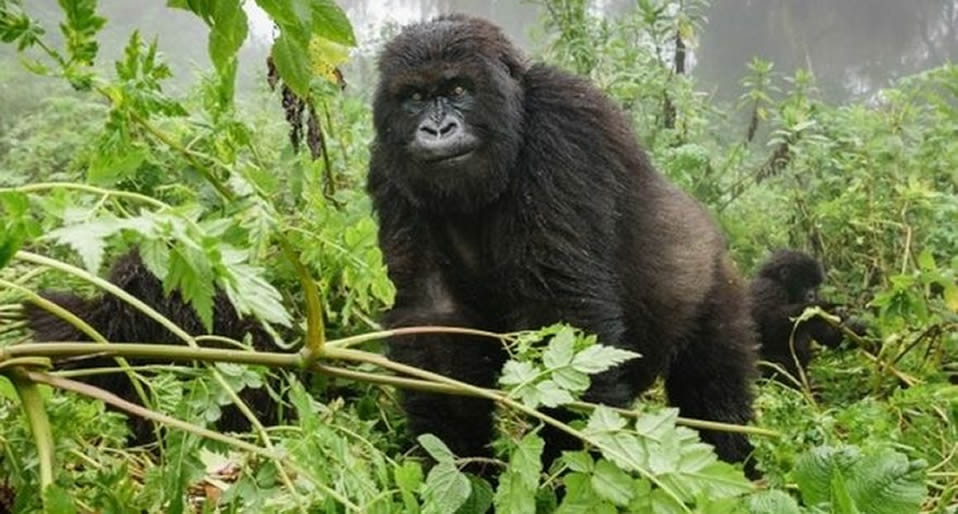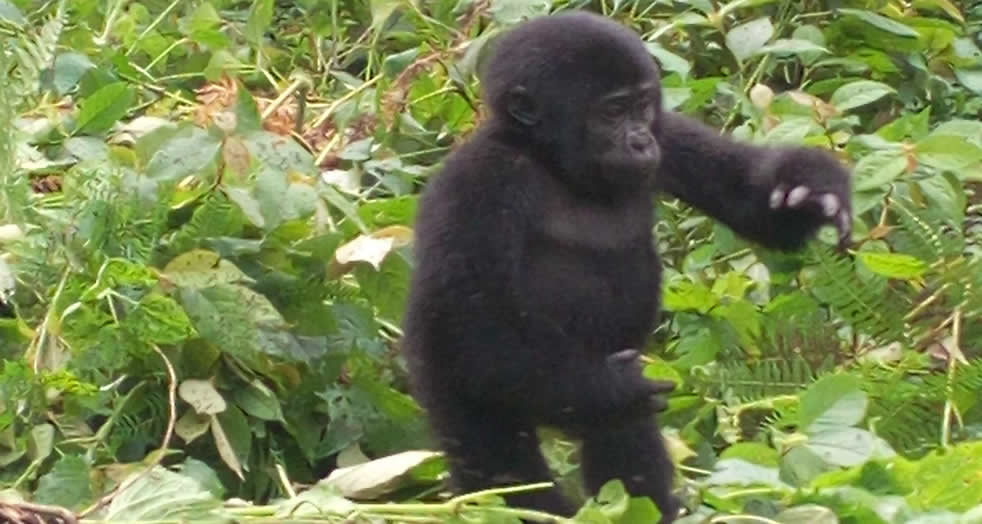An overview of a mountain gorilla
A mountain gorilla is one of the two subspecies of the eastern gorilla- gorilla beringei. Mountain gorillas are listed among the endangered species with an estimated 1004 individuals in two populations as of 2018. One population lives in Uganda’s Bwindi impenetrable national park and the other in the Virunga mountains– in three adjacent national parks- Mgahinga gorilla national park, Rwanda’s volcanoes national park and Virunga national park in the Democratic Republic of Congo.
Mountain gorillas display uncanny human characteristics. They live, walk, feed and do their daily activities in groups. These close-knit family groups are headed by a mature male Silverback- who selects places for groups to eat and sleep and has many privileges including the right to feed first. Mountain gorillas are gentle species, highly intelligent, and communicate using a variety of vocal sounds.
What makes up a gorilla group?
For the longest time, gorillas have been seen to move, live and form families also called social groups. Another name for a gorilla group is a ‘troop’ which averagely consists of 10-15 members or more. Each gorilla group is headed by a silverback- a mature male gorilla whose role is to defend the troop at any cost.
What constitutes a gorilla family?
A gorilla family constitutes a relatively stable cohesive structure that holds gorilla species together by long-term bonds between adult males and females. Aside from a few exceptions, a gorilla group consists of more adult females than males.

Baby Gorilla Bwindi Forest – Uganda
The dominant types of gorilla groups
- Natal group
This is usually a social group into which an individual gorilla is born. Although not common, males and females may remain in their natal groups for their entire lives. Those which are unable to stay in the natal group usually disperse to create new groups.
- Male-female groups
These are usually the most common of all gorilla families consisting of a mature silverback and adult females together with their young.
- Bachelor (all male) groups
These are usually solitary male gorillas that roam alone from time to time looking for an opportunity to acquire females from other groups to create a family of their own. In case any of these males is unsuccessful, it may roam around until it gets successful. The bachelor group helps the male gorillas to learn leadership skills they will need to run a gorilla family of their own. Just like in the male-female groups, bachelor groups are led by a dominant male silverback.
Hierarchy in a gorilla family
Hierarchy is an important factor in a gorilla family and this exists among both male and female gorillas. Among the male gorillas, the adult male silverback is usually dominant over the rest and makes decisions such as where to sleep and eat. Although there may be multiple adult silverbacks in the group, these may aid in protecting the group as well as solving conflicts.
On the other hand, the hierarchy among females is based on age as well as an individual’s length of time in a group. However, a young female could rise in status if the dominant male is particularly interested in her. Alternatively, some factors such as bring forth an offspring may change the hierarchy among female gorillas, where females with newborns usually rise in rank.
Role of each member in a gorilla family
Female Gorilla Bwindi Forest – Uganda
- Mature male Silverback
The mature silverback is charged with defending the gorilla family at any cost. It also selects places where the group may eat and sleep. It possesses privileges including the right to feed first, mating with the females in a group among others.
- Elderly females
These are usually responsible for producing as well as nursing infants. Mature female gorillas also serve motherly roles in the gorilla family.
- Juveniles
These are usually the younger infants and their responsibility is to keep the group lively and fun.
How do gorillas form groups?
Mountain gorillas form groups based on several factors but most commonly gorilla groups are as a result of the dispersal of a natal group. This is often after the death of the male silverback which leaves the group with no leader once the males therein don’t take on responsibility.
How is a gorilla group given a name?
Gorilla groups are oftentimes named according to a number of factors. Most importantly, a number of gorilla families have been named after the dominant male or the place where the group was first sighted. Other gorilla families are named according to their formation history, group location among others.
Mountain gorilla groups in Uganda
Uganda has about 18 habituated mountain gorilla groups, with 17 lying in Bwindi impenetrable national park and one gorilla family at Mgahinga gorilla national park. Gorilla families in Bwindi include Mubare, Habinyanja, Rushegura, Bitukura, Oruzogo, Nkuringo, Mishaya, Kahungye, Bweza, Busingye, Nsongi, Bikyingi, Rwigi, Katwe, Mucunguzi, Bushaho, Mukiza, and Kyaguriro for research. They are found along with four main trailheads (sectors) a visitor can use to track the above gorilla families including Buhoma, Nkuringo, Ruhija, and Rushaga. While at Mgahinga national park, visitors can trek Nyakagezi gorilla family.
Where to go on a gorilla safari in Rwanda and Uganda?
Uganda’s mountain gorillas are found in Bwindi impenetrable national park and Mgahinga national park. The bwindi impenetrable national park lies in southwestern Uganda and is part of Bwindi impenetrable forest. The park contains over 400 mountain gorillas roughly half of the world’s total population with 18 habituated mountain gorilla groups which can be tracked. On the other hand, Mgahinga gorilla national park is situated in southwestern Uganda. The park has a population of about 80 mountain gorillas with one habituated gorilla family.
On the other hand in Rwanda, memorable gorilla safari adventures take place in the Magnificient Volcanoes National park with currently more than 15 habituated gorilla groups and they include the following;
- The Igisha Group – Susa B
- Pablo Gorilla Group
- Kurira – Susa A Gorilla Family
- Gushimira Group
- Kwitonda Family
- Umubano Group
- Titus Gorilla Group
- Agasha Gorilla Family
- Isimbi Gorilla Group
- Musilikale Gorilla Group
- Muhoza Gorilla Family
- Amahoro Gorilla Family
- Mafunzo Gorilla Family
- Hirwa Gorilla Group
- Isabukuru Gorilla Family
- Karisimbi Gorilla Family
- Bwenge Gorilla Family
When can you visit a gorilla group in Uganda?
Gorilla safaris in Uganda can be done throughout the year whether one travels during a low season month or peak season. The best time to visit a mountain gorilla family in Uganda would be during the months of June to August and December to February. This is because during the fore mentioned months; the tracking trails are not very slippery and the gorillas are easy to spot, unlike the rainy season where gorillas tend to take shelter in the forests and are quite hard to spot. Alternatively, the favourable seasons to go gorilla trekking for visitors travelling on a tight budget would be between March to April and October to November. These are considered as low season months because of the frequent rains experienced in the country, and expect discounts on accommodations and car rental.


